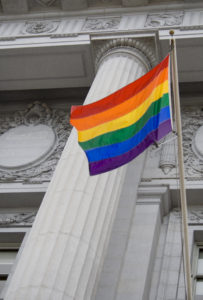Taiwan voters rejected same-sex marriage in a referendum Saturday, dealing a blow to the LGBT community and allies who hoped the island would become the first place in Asia to allow same-sex unions.


Ever since scientists created the powerful gene editing technique Crispr, they have braced apprehensively for the day when it would be used to create a genetically altered human being. Many nations banned such work, fearing it could be misused to alter everything from eye color to I.Q.
Now, the moment they feared may have come. On Monday, a scientist in China announced that he had created the world’s first genetically edited babies, twin girls who were born this month.
The researcher, He Jiankui, said that he had altered a gene in the embryos, before having them implanted in the mother’s womb, with the goal of making the babies resistant to infection with H.I.V. He has not published the research in any journal and did not share any evidence or data that definitively proved he had done it.
But his previous work is known to many experts in the field, who said — many with alarm — that it was entirely possible he had.
“It’s scary,” said Dr. Alexander Marson, a gene editing expert at the University of California in San Francisco.
While the United States and many other countries have made it illegal to deliberately alter the genes of human embryos, it is not against the law to do so in China, but the practice is opposed by many researchers there. A group of 122 Chinese scientists issued a statement calling Dr. He’s actions “crazy” and his claims “a huge blow to the global reputation and development of Chinese science.”
If human embryos can be routinely edited, many scientists, ethicists and policymakers fear a slippery slope to a future in which babies are genetically engineered for traits — like athletic or intellectual prowess — that have nothing to do with preventing devastating medical conditions.
While those possibilities might seem far in the future, a different concern is urgent and immediate: safety. The methods used for gene editing can inadvertently alter other genes in unpredictable ways. Dr. He said that did not happen in this case, but it is a worry that looms over the field.
Dr. He made his announcement on the eve of the Second International Summit on Human Genome Editing in Hong Kong, saying that he had recruited several couples in which the man had H.I.V. and then used in vitro fertilization to create human embryos that were resistant to the virus that causes AIDS. He said he did it by directing Crispr-Cas9 to deliberately disable a gene, known as CCR₅, that is used to make a protein H.I.V. needs to enter cells.
By Gina Kolata, Sui-Lee Wee and Pam Belluck, NYTimes.com – November 26, 2018
Click here to read the entire article.
At least two Dutch clinics will start offering surrogacy to gay couples next year – MC Kinderwens in Leiderdorp and Nij Geertgen clinic in Elsendorp. In Leiderdorp the surrogate mother must also donate the egg. In Elsendorp the surrogate and egg donor may be different people.

“I think it’s too crazy for words that gay couples, but also women with oncological complaints for example, have to go abroad to fulfill their desire to have children”, Nij Geertgen director Marc Scheijven said to De Monitor. “While we have all medical and technical experience in house.”
By Janene Pieters on November 13, 2018 nltimes.nl
Click here to read the entire article.
“What I must tell you is very difficult for me and is taking all the courage I can muster,” the letter said. “I have felt imprisoned in a body that does not match my mind, and this has caused me great despair and loneliness.”
“I will return to work as my true self, Aimee Australia Stephens, in appropriate business attire,” she wrote. “I hope we can continue my work at R. G. and G. R. Harris Funeral Homes doing what I always have, which is my best!”
Ms. Stephens had worked there for six years. Her colleagues testified that she was able and compassionate.
“He was a very good embalmer,” one said. “He was very, very thorough. Had obviously had a lot of practice prior to coming to the Harris Funeral Home. Families seemed very pleased with his work. He did a good job.”
Two weeks after receiving the letter, though, the home’s owner, Thomas Rost, fired Ms. Stephens. Asked for the “specific reason that you terminated Stephens,” Mr. Rost said: “Well, because he was no longer going to represent himself as a man. He wanted to dress as a woman.”
Mr. Rost also said he did not want to address Ms. Stephens as Aimee. “I’m uncomfortable with the name,” Mr. Rost said, “because he’s a man.”
The case went to court, and Ms. Stephens won in the United States Court of Appeals for the Sixth Circuit, in Cincinnati. Discrimination against transgender people, the court ruled, was barred by Title VII of the Civil Rights Act of 1964, which forbids discrimination on the basis of sex.
“It is analytically impossible to fire an employee based on that employee’s status as a transgender person without being motivated, at least in part, by the employee’s sex,” the court said. “Discrimination ‘because of sex’ inherently includes discrimination against employees because of a change in their sex.”
by Adam Liptak, NYTimes.com, November 12, 2018
Click here to read the entire article.
Now, the Scottish government will mandate all state schools introduce a curriculum that explains the history of lesbian, gay, bisexual, transgender and intersex (LGBTI) activism. Schools will also educate students on the use of LGBTI terminology and discuss ways to address homophobia.
“Our education system must support everyone to reach their full potential,” Scottish Deputy First Minister John Swinney said Thursday. “The recommendations I have accepted will not only improve the learning experience of our LGBTI young people, they will also support all learners to celebrate their differences, promote understanding and encourage inclusion.”
The move came after a campaign called Time for Inclusive Education presented a series of suggestions to the Scottish government. According to a 2016 research report on the Scottish LGBTI community published by the group, “90% of LGBT people have experienced homophobia, biphobia or transphobia at school.” The same research found that 27 percent of LGBTI people had attempted suicide — some more than once.
Scottish ministers adopted all of the recommendations from the campaign’s working group. The Guardian reported there will not be options to opt out of the curriculum, which will be interspersed throughout various subjects.
Swinney said this makes Scotland “the first country in the world to have LGBTI-inclusive education embedded within the curriculum.”
In recent years, Scotland has reckoned with its legacy of discrimination against the LGBTI community.
In a unanimous vote in June, Scottish lawmakers chose to pardon men who were previously charged with participating in homosexual acts. The BBC reported at the time that sexual relations between two men was decriminalized in Scotland in 1981. Some of the acts that were previously considered illegal and for which gay men are now being pardoned included consensual sex in private, or even acts such as kissing in public. In some cases, men perceived as flirting with another man could also have been charged.
Thousands of men were to be pardoned after the law was passed in June. But when it comes to the LGBTI community, there are still divisions within Scottish society, especially among religious leaders.
Washington Post, by Siobhan O’Grady – Nomvemb er 9, 2018
Click here to read the entire article.
On a night when the Democratic Party achieved a net gain of somewhere between 30 and 35 seats in the US House of Representatives, wresting control from the Republicans and finally putting some check on President Donald Trump, the LGBTQ community enjoyed key victories, including the election of the nation’s first out gay governor and the defeat of an anti-transgender ballot initiative in Massachusetts.
The Massachusetts referendum resulted from the efforts of anti-trans activists to repeal a 2016 law that guaranteed equal access to public accommodations regardless of gender identity. A yes vote upheld that law and garnered roughly 70 percent of the vote, after a hard-fought campaign.
In a written statement, Carol Rose, the executive director of the ACLU of Massachusetts said voters “reaffirmed our Commonwealth as a place that fiercely defends our basic values of dignity and respect for everyone. At a time when transgender rights are being threatened nationally, we absolutely must preserve the rights we have secured at the state level.”
In Colorado, Jared Polis, an out gay Democrat elected to Congress in 2008, was elected governor with a margin of about seven percentage points. Polis succeeds two-term Democratic Governor John Hickenlooper.
“Every Coloradan wants good schools, healthy communities, and more opportunity for the next generation,” Polis said in a written statement. “So the time is now to unite in our common purpose, rooted in our shared love for our home of Colorado, and move forward together, confident that what makes us unique isn’t just the boldness of our ideas — it’s the resilience and the spirit of Coloradans, who make change happen, who bring these bold ideas to life.”
In Oregon, Governor Kate Brown, an out bisexual Democrat who took office in 2015 after her predecessor resigned and won a special election the following year, held on to her office, with a five percent margin over her Republican opponent.
In Arizona, Kyrsten Sinema, an out bisexual member of Congress first elected in 2012, trails her Republican opponent, Martha McSally, who was elected to the House two years later, by about 16,000 votes. According to CBS News, however, there are more than one million early ballot votes that have not yet been tallied, so it will be at least several days until that race is called.
The Democrats’ sweep of the House saw the election of at least four new LGBTQ representatives: Christopher Pappas, who will be New Hampshire’s first LGBTQ member of Congress; Angie Craig, Minnesota’s first out lesbian or gay person elected to the House after defeating Jason Lewis, an outspokenly anti-gay Republican representing suburban Minneapolis; Katie Hill, who defeated anti-gay California Republican Steve Knight; and Sharice Davids, who will be Kansas’ first out lesbian or gay member of Congress and the first Native American woman to serve there. (Gina Ortiz Jones trails Texas Republican incumbent Will Hurd by about 1,200 votes in unofficial returns, but that race has not yet been called.)
Gay City News, by Paul Schindler, November 8, 2018
Click here to read the entire article.
A series of decisions by the Obama administration loosened the legal concept of gender in federal programs, including in education and health care, recognizing gender largely as an individual’s choice and not determined by the sex assigned at birth. The policy prompted fights over bathrooms, dormitories, single-sex programs and other arenas where gender was once seen as a simple concept. Conservatives, especially evangelical Christians, were incensed.
Now the Department of Health and Human Services is spearheading an effort to establish a legal definition of sex under Title IX, the federal civil rights law that bans gender discrimination in education programs that receive government financial assistance, according to a memo obtained by The New York Times.
The department argued in its memo that key government agencies needed to adopt an explicit and uniform definition of gender as determined “on a biological basis that is clear, grounded in science, objective and administrable.” The agency’s proposed definition would define sex as either male or female, unchangeable, and determined by the genitals that a person is born with, according to a draft reviewed by The Times. Any dispute about one’s sex would have to be clarified using genetic testing.
“Sex means a person’s status as male or female based on immutable biological traits identifiable by or before birth,” the department proposed in the memo, which was drafted and has been circulating since last spring. “The sex listed on a person’s birth certificate, as originally issued, shall constitute definitive proof of a person’s sex unless rebutted by reliable genetic evidence.”
The new definition would essentially eradicate federal recognition of the estimated 1.4 million Americans who have opted to recognize themselves — surgically or otherwise — as a gender other than the one they were born into.
“This takes a position that what the medical community understands about their patients — what people understand about themselves — is irrelevant because the government disagrees,” said Catherine E. Lhamon, who led the Education Department’s Office for Civil Rights in the Obama administration and helped write transgender guidance that is being undone.
The move would be the most significant of a series of maneuvers, large and small, to exclude the population from civil rights protections and roll back the Obama administration’s more fluid recognition of gender identity. The Trump administration has sought to bar transgender people from serving in the military and has legally challenged civil rights protections for the group embedded in the nation’s health care law.
Several agencies have withdrawn Obama-era policies that recognized gender identity in schools, prisons and homeless shelters. The administration even tried to remove questions about gender identity from a 2020 census survey and a national survey of elderly citizens.
By Erica L. Green, Katie Benner and Robert Pear, New York Times, October 21, 2018
Click here to read the entire article.
Mr. Shepard’s killing in 1998, when he was a 21-year-old college student, led to national outrage and, almost overnight, turned him into a symbol of deadly violence against gay people.
Mourners flocked to his funeral that year in Casper, Wyo., but there were also some protesters, carrying derogatory signs. Mr. Shepard’s parents worried that if they chose a final resting place for their son, it would be at risk of desecration.
Now they have found a safe place. On Oct. 26, Mr. Shepard will be interred at the Washington National Cathedral, the neo-Gothic, Episcopal house of worship that is a fixture of American politics and religion.
“I think it’s the perfect, appropriate place,” Dennis Shepard, Matthew’s father, said in an interview on Thursday. “We are, as a family, happy and relieved that we now have a final home for Matthew, a place that he himself would love.”
Two decades ago, Matthew Shepard was robbed by two men, pistol-whipped and tied to a fence in Laramie. He hung there bleeding in near-freezing temperatures until a passing bicyclist spotted him, thinking at first that he was a scarecrow. He later died in a hospital.
“His death was a wound on our nation,” Mariann Edgar Budde, the bishop of the Episcopal Diocese of Washington, said in an interview on Wednesday. “We are doing our part to bring light out of that darkness and healing to those who have been so often hurt, and sometimes hurt in the name of the church.”
The elder Mr. Shepard said his family had long searched for a fitting resting place for his son, who was once an altar boy in the Episcopal Church. They considered spreading his ashes over the mountains and plains of Wyoming, but still wanted a place they could visit to talk to him. They considered splitting the ashes.
At the cathedral, not only will the family be able to visit him, but so will guests from across the world.
“It’s a place where there’s an actual chance for others to sit and reflect about Matthew, and about themselves, and about their friends,” Mr. Shepard’s father said.
by Jacey Fortin, NYTimes.com, October 11, 2018
Click here to read the entire article.
Kianni Arroyo clasps 8-year-old Sophia’s hands tightly as they spin around, giggling like mad. It’s late afternoon, and there are hot dogs on the grill, bubble wands on the lawn, balls flying through the air.
The midsummer reunion in a suburb west of the city looks like any other, but these family ties can’t be described with standard labels. Instead, Arroyo, a 21-year-old waitress from Orlando, is here to meet “DNA-in-laws,” various “sister-moms” and especially people like Sophia, a cherished “donor-sibling.”
Sophia and Arroyo were both conceived with sperm from Donor #2757, a bestseller. Over the years, Donor #2757 sired at least 29 girls and 16 boys, now ages 1 to 21, living in eight states and four countries. Arroyo is on a quest to meet them all, chronicling her journey on Instagram. She has to use an Excel spreadsheet to keep them all straight.
“We have a connection. It’s hard to explain, but it’s there,” said Arroyo, an only child who is both comforted and weirded-out by her ever-expanding family tree.
Thanks to mail-away DNA tests and a proliferation of online registries, people conceived with donated sperm and eggs are increasingly connecting with their genetic relatives, forming a growing community with complex relationships and unique concerns about the U.S. fertility industry. Like Arroyo, many have discovered dozens of donor siblings, with one group approaching 200 members — enormous genetic families without precedent in modern society.
Because most donations are anonymous, the resulting children often find it almost impossible to obtain crucial information. Medical journals have documented cases in which clusters of offspring have found each other while seeking treatment for the same rare genetic disease. The news is full of nightmarish headlines about sperm donors who falsified their educational backgrounds, hid illnesses or turned out to be someone other than expected — such as a fertility clinic doctor.
By Ariana Eunjung Cha , Washington Post, September 12, 2018
Click here to read the entire article.
The report, issued on Monday by the Intergovernmental Panel on Climate Change, a group of scientists convened by the United Nations to guide world leaders, describes a world of worsening food shortages and wildfires, and a mass die-off of coral reefs as soon as 2040 — a period well within the lifetime of much of the global population.
The report “is quite a shock, and quite concerning,” said Bill Hare, an author of previous I.P.C.C. reports and a physicist with Climate Analytics, a nonprofit organization. “We were not aware of this just a few years ago.” The report was the first to be commissioned by world leaders under the Paris agreement, the 2015 pact by nations to fight global warming.
The authors found that if greenhouse gas emissions continue at the current rate, the atmosphere will warm up by as much as 2.7 degrees Fahrenheit (1.5 degrees Celsius) above preindustrial levels by 2040, inundating coastlines and intensifying droughts and poverty. Previous work had focused on estimating the damage if average temperatures were to rise by a larger number, 3.6 degrees Fahrenheit (2 degrees Celsius), because that was the threshold scientists previously considered for the most severe effects of climate change.
Avoiding the most serious damage requires transforming the world economy within just a few years, said the authors, who estimate that the damage would come at a cost of $54 trillion. But while they conclude that it is technically possible to achieve the rapid changes required to avoid 2.7 degrees of warming, they concede that it may be politically unlikely.
For instance, the report says that heavy taxes or prices on carbon dioxide emissions — perhaps as high as $27,000 per ton by 2100 — would be required. But such a move would be almost politically impossible in the United States, the world’s largest economy and second-largest greenhouse gas emitter behind China. Lawmakers around the world, including in China, the European Union and California, have enacted carbon pricing programs.
New York Times – October 8, 2018 by Coral Davenport
Click here to read the entire article.